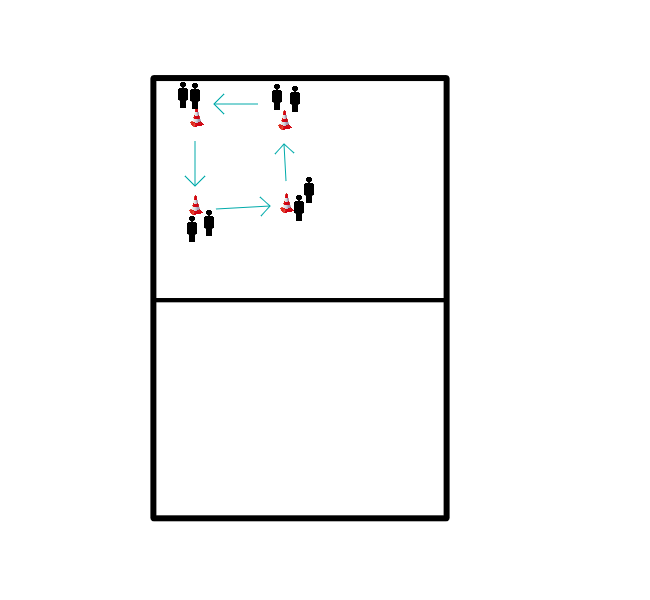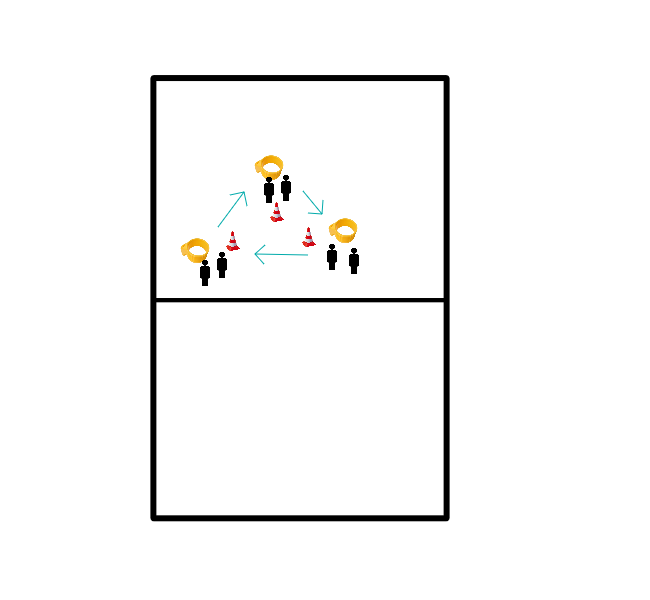Korfball exercises for u12
You put four pawns in a square with a distance of 8 metres. Then you let the children make pairs. The children may take turns rolling the dice. You have three different rounds:
Round 1:
The children roll the dice. For example, if a group throws 4, each group must run 4 laps around the pawns.
Round 2:
The children first say who they are going to roll the dice for and then they get to roll passes. So they pick a group, say group 2 and roll the dice for that group.
Round 3:
The children first get to roll the dice and then they pick a group. This is almost always the most fun round. 
You put up three poles in a triangle, in the middle of the three poles you put a pawn. Three children are placed as attackers and the other children stand near the pawns.
First, you can choose that the attackers have to run through the poles. It doesn't matter which pole they hit, they can hit the same pole twice in a row. You can choose for this, so they have to run a lot. Also the children have to score 2 times, the person who scores first can trade with a declarator, the other children can trade with a declarator.
After that you can choose to letthe children do free balls, penalty throws, foul balls etc.
Everyone lies down on the floor like a plank, supporting themselves on their elbows with their legs extended. Then the children jump up and stretch all the way.
The whole group walks a circle around the yellow lines in the middle in a line. When the trainer calls 'yes', the person at the back of the line starts running as fast as possible. The children do this by pulling a sprint.
Options:
The children run after each other around the yellow lines in a line. The person at the front of the line can do whatever he wants for example: heels buttocks, sprints, lifts his knees etc. Whenthe trainer calls 'yes' the person at the back of the line starts to run as fast as possible and can choose what he wants to do. It must be something other than normal running/jogging, it may be sprinting.
 You have a pair at each pole, so the amount of poles depends on the size of the group. Everyone starts with scoring twice on the pole, when they have done this they go to the next pole. It can happen that two groups are standing at the same pole, this is because they don't all have to turn. The pairs only have to pass when they have scored twice.
You have a pair at each pole, so the amount of poles depends on the size of the group. Everyone starts with scoring twice on the pole, when they have done this they go to the next pole. It can happen that two groups are standing at the same pole, this is because they don't all have to turn. The pairs only have to pass when they have scored twice.
Place a pawn in front of the pole at a good distance for your team.
You make a square, in it stands an attacker, the attacker must keep moving in the square while a defender walks by. 1 person always plays the ball. The defender looks at the ball and tries to catch it. Every time the attacker catches the ball, someone else comes into the box. When the defender catches the ball, he throws it back and you try again.
The children make a walk-through ball in front of the basket and a walk-through ball behind the basket. If they both hit the hoop, they have three points. The first player to get three points wins.
Place a number of cones/caps 2 to 3 metres apart. Make two rows of cones and divide the team into two groups.
The exercise is quite simple. Two pawns spinning and one pawn in defensive position back. Then repeat the exercise again, so two pawns forward and one pawn back.
You make a square, in it stands an attacker, the attacker must keep moving in the square while a defender walks by. 1 person always plays the ball. The defender looks at the ball and tries to catch it. Every time the attacker catches the ball, someone else comes into the box. When the defender catches the ball, he throws it back and you try again.
At the end of the training, play a game of 4 against 4 on 1 basket.
Nr.1 has the ball and after the start signal passes to Nr.2, etc. The distance between the players is 2 m. The last player runs forward after receiving the ball, taps the wall (or other point). Places on nr.1 and goes in front of the line. 1 places again on 2, etc.Â
This continues until the whole row has moved forward and no. 1 is in front again.
Organisation:
Two parties, 1 attacking and 1 defending party. Three or four baskets and a ball.
Exercise:
How much time does a team need to score a goal in all the baskets?
The basket that has been scored in may not be used again, so that the difficulty factor increases. The defender gives the ball back after interception.








